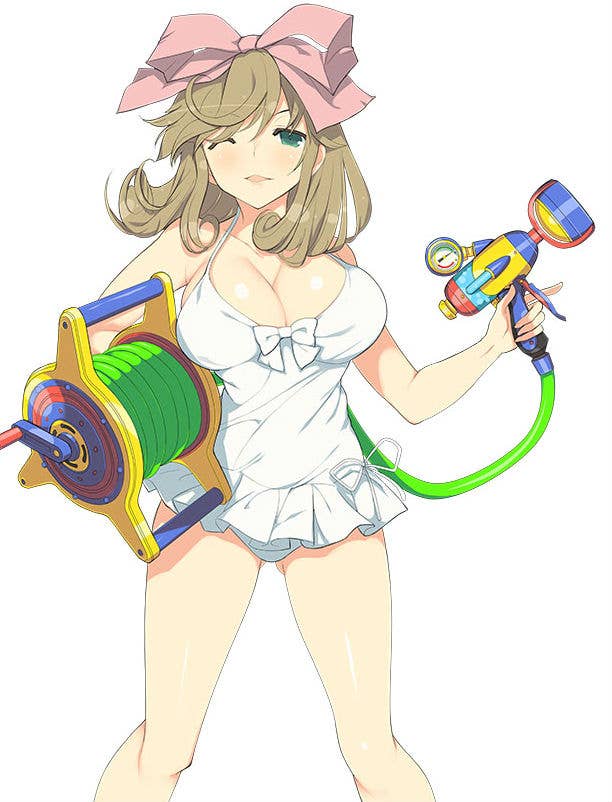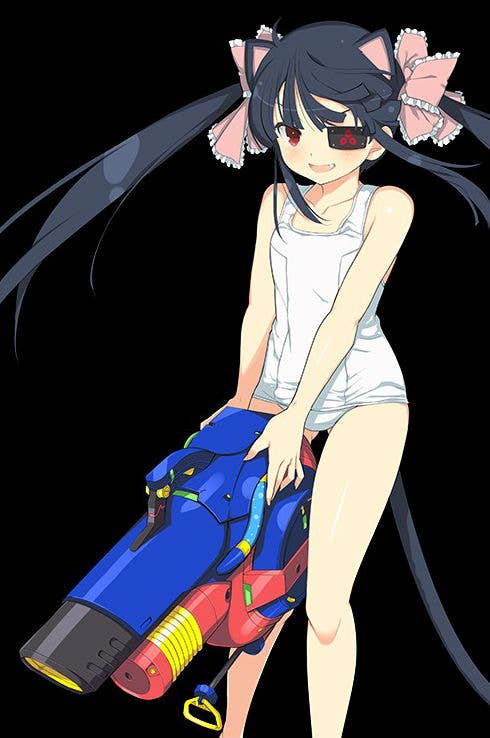Sex and gaming: Selling Japan's Senran Kagura to the West
Marvelous Entertainment's Michael Fisher and Harry Holmwood discuss the challenges and surprises this series presents
The first thing you probably think of when you hear the name Senran Kagura - if you've even heard of the franchise at all - is questionable imagery of girls in bikinis.
Published by Marvelous Entertainment, the series is a Japanese-developed affair that centres around female ninjas almost always in various states of undress. Perhaps the sort of IP most Western businesses - or, indeed, consumers - will dismiss but Senran Kagura sells moderately well and has been appearing with increasing frequency in the games media, particularly with recent spin-off Peach Beach Splash.
We caught up with the publisher to find out if there's more to these games than the artwork suggests.

"If you were to ask a fan, they would tell you about the deep story and all the characters involved - and there is a lot of that," marketing manager Michael Fisher tells GamesIndustry.biz.
"The thing is you can't ignore the sexual nature to it: the artwork, the graphics. It's gratuitous, but it's meant to be and it's in such a way that it can almost be viewed as tongue-in-cheek in a lot of ways."
The core games in the series are action adventures, which see the girls taking on various enemy ninjas and giant monsters with outlandish weapons and a combat system that focuses on racking up combos - nothing too unusual for video games. Some entries veer into more unexpected territory, such as the water pistol shooter Peach Beach Splash, mobile card battler New Wave or rhythm action cooking game Bon Appétit.
Perhaps the most surprising aspect of Senran Kagura's success is the audience. One glance at the character art and it's easy to concoct the mental image of a hormonally driven teenage boy pouring hours into these games purely for the titillation - but Fisher reveals that's not the reality.
"A good portion of our fanbase is actually female," he says. "Probably 30% to 40%, for sure. Age-wise, 20 to 25 is the main bracket - not teenagers. Everyone I know who plays the game and likes the series falls within that category. It's a surprising thing."
Fisher also tells us fans praise the solid and enjoyable action gameplay. A quick trip to Metacritic shows most of the core entries score around the respectable 70 mark, and the user score is almost always higher. If this is the case, why bother with the sexualised wrapping at all? Is there not a danger that it detracts from the gameplay and automatically limits the audience?
"A good portion of our fanbase is actually female - probably 30% to 40%. Age-wise, 20 to 25 is the main bracket - not teenagers"
Michael Fisher, Marvelous
"It's part of the identity of the game," Fisher explains. "To take that away would be like losing something - and obviously all the fans would get really angry. Also, don't forget that kind of stuff is hugely popular in Japan. The games do really well there."
It's worth giving more context to "really well". Marvelous' European general manager Harry Holmwood tells us each entry sells a few hundred thousands units around the world - with a "significant portion" being in the series' home market of Japan. But there are other regions where Senran Kagura is becoming increasingly popular.
"China has become very big for these games, particularly on Steam," says Holmwood. "Of course, it's not a million selling series. It's not even a huge game in Japan, it's still a bit of a niche in that market [and] an outlier back there."
He continues: "It's a niche series over here [in Europe], but it's growing. For the first time, we've localised into French - France is huge on anime in general. You can actually go into corner shops and find 18+ hentai on the shelf. So France is a really big market for us, and Germany is too. I believe it was the fourth largest for sales of Valkyrie Drive. So the EU is a great market for us, and every game that comes out sells more and more units. Our audience has grown."

Valkyrie Drive, for those unfamiliar with the IP, is another series by the same producer: Kenichiro Takaki. Far more gratuitous than Senran Kagura, this sees players guide a lesbian couple through various over the top battles where stimulating one girl will allow her to transform into a weapon for the other.
It isn't hard to imagine how difficult it must be to sell or even promote either Valkyrie Drive or Senran Kagura in the West, where sensitivities to such content are much higher. Nevertheless, sales for the earliest titles encouraged Marvelous to continue rolling out the latter series across Europe.
"There are some strict advertising guidelines, like no showing of cleavage. We have assets that adhere to that - it's fewer compared to the ones that don't"
Michael Fisher, Marvelous
"It surprised everyone," says Holmwood. "First of all with its success in Japan, and then with the success outside of that market. We didn't really know what to expect when we put out Valkyrie Drive on Steam, but in the first week it sold as many as we were forecasting for the first year. So clearly there is a demand for this."
Fisher adds: "With our special editions, we've always seemed to produce a sufficient amount that sells out a week before launch."
Holmwood reflects on the earliest work on Senran Kagura, and how Marvelous "dipped our toes quite gently" when it came to releasing in the West. To begin with, the games were only released digitally.
"We were uncertain whether there would be a market for Senran Kagura, whether it would be acceptable," he recalls. "The first time we did physical, we did a super limited run and it wasn't through retail, it was direct to consumers from our website - and we sold out. It was a small number, but it showed that audience was there, and we've just built on that."
As demand grew, Marvelous began experimenting with special editions featuring artwork and merchandise built around the characters - something that boosted the publisher's capabilities when it came to releasing the standard units at retail.
"That allowed us to minimise our risk going to market," Holmwood explains. "Day one, we pre-sold enough units of the first Senran Kagura game to pay for all of the copies. We were able to enter the market for physical product effectively risk free. In doing so, that allowed us a direct relationship with the most hardcore consumers that we continue to build on."
While Senran Kagura has proven there is demand for such games in the West, Holmwood doesn't believe it's something you'd ever see from Western game makers. Japanese origins are part of the series' charm, and something that couldn't be recreated even by a team full of ardent fans.
"No Western developer is ever going to make one of these games," he says. "They're just not culturally acceptable for us to make. You can bring it over as a piece of Japanese culture, but there are still things you can get away with over there that would cross the line for us."

The Marvelous duo also tell us that, somewhat surprisingly, little to no censorship is required to bring Senran Kagura games to Western shelves. The only alteration is the removal of characters' ages, a decision made for the very first release. This is understandable when you consider just how young some of these characters are meant to be. A controversial situation like this became very public when Nintendo made the same decision around the game Xenoblade Chronicles X.
In 2015, it was reported that a 13-year-old character had been aged up to 15 in the Western localisation. This proved to be unchanged in the final version but her costumes were changed to be considerably less revealing. Both this change, and the notion of the age alteration, prompted complaints from the game's followers. Has making the characters older not prompted a similar outcry among Senran Kagura fans?
"We don't really get backlash about that particular aspect, because it's something we've done for every Senran Kagura," Fisher explains. "Our fans are quite accepting of that kind of thing, so beyond that we don't do any kind of censorship for the game. We just follow the rules set by the age ratings boards."
Even when following these rules, Senran Kagura has been difficult to pass through certain ratings boards. Fisher reports "a lot of back and forth" with German organisation USK over this year's Peach Beach Splash.
"We were refused classfication at first, but when we appealed it we got an 18 rating," he says. "It just involved a bit of a wait for things to flow through."
"An indie game on Steam is very unlikely to sell as much as Senran Kagura. We're not FIFA, but we're still successful."
Harry Holmwood, Marvelous
Guidelines also come into play when it comes to advertising the games, either through traditional channels like print and online banner ads or even social media. Again, Marvelous assures us that a lot of effort goes into following these rules.
"There are some strict guidelines, like no showing of cleavage and things like that," says Fisher. "We do have artwork that adheres to that - it's just a smaller portion of assets compared to the ones that don't.
"The quality of the game sells quite well. If we make a trailer that has less of the sexiness and more of the action gameplay, that spreads a bit more and people become intrigued about the series. There's always a nice quality to the Senran Kagura games, in terms of the way they play and the way they feel. Word of mouth is a big part of it, although not all of it.
"It can be difficult, because the sexiness is a big part of Senran Kagura and you want to promote that, but you need to hold back on some aspects of it. We nail a good middle ground with our trailers, showing off the action and the gameplay. It has its difficulties, though, for sure."
As the series has grown, you might think awareness might also increase outside video game circles - including the mainstream press. UK tabloids alone would have a field day passing judgement on the games' gratuitous stylings, but Senran Kagura has (so far) largely avoided the wrath of the media.
The exception has been Peach Beach Splash, with the announcement being covered by The Sun. The tone of the article was made obvious through its use of phrases like "grubby boys" and "creepy wet t-shirt game" - "Which is a bit rich coming from The Sun," says Holmwood.
Fisher adds: "I think being a Japanese game, people almost expect it. So I think it flies a little under the radar for the mainstream media, it's just dismissed as a Japanese thing. When we do get coverage from something like The Sun, we find it quite humourous, we don't take it in bad faith or get angry or anything.
"Everyone has their opinion of what Senran Kagura is. To the fans, it's a rich storytelling game with great characters. From an outsider's point of view, it's probably something completely different."
Of course, Marvelous isn't overly concerned with reaching that wider audience. The series is profitable enough to continue releasing in the West and, both Holmwood and Fisher point out, only part of a business that also provides family-friendly mobile games and Harvest Moon successor Story of Seasons.
Holmwood concludes: "We've got a very devoted audience so we know that so long as a good job is done with the conversion and localisation - which there always is - we know we're going to hit a certain threshold of units. And it's higher than you might get if you published an indie game, for example. An indie game on Steam is very unlikely to sell as much as Senran Kagura. We're not FIFA, but we're still successful."








